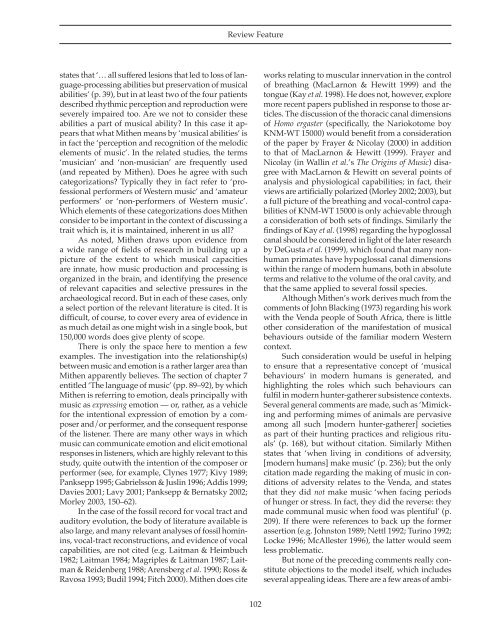The Singing Neanderthals: the Origins of Music, Language, Mind ...
The Singing Neanderthals: the Origins of Music, Language, Mind ...
The Singing Neanderthals: the Origins of Music, Language, Mind ...
Create successful ePaper yourself
Turn your PDF publications into a flip-book with our unique Google optimized e-Paper software.
states that ‘… all suffered lesions that led to loss <strong>of</strong> language-processing<br />
abilities but preservation <strong>of</strong> musical<br />
abilities’ (p. 39), but in at least two <strong>of</strong> <strong>the</strong> four patients<br />
described rhythmic perception and reproduction were<br />
severely impaired too. Are we not to consider <strong>the</strong>se<br />
abilities a part <strong>of</strong> musical ability? In this case it appears<br />
that what Mi<strong>the</strong>n means by ‘musical abilities’ is<br />
in fact <strong>the</strong> ‘perception and recognition <strong>of</strong> <strong>the</strong> melodic<br />
elements <strong>of</strong> music’. In <strong>the</strong> related studies, <strong>the</strong> terms<br />
‘musician’ and ‘non-musician’ are frequently used<br />
(and repeated by Mi<strong>the</strong>n). Does he agree with such<br />
categorizations? Typically <strong>the</strong>y in fact refer to ‘pr<strong>of</strong>essional<br />
performers <strong>of</strong> Western music’ and ‘amateur<br />
performers’ or ‘non-performers <strong>of</strong> Western music’.<br />
Which elements <strong>of</strong> <strong>the</strong>se categorizations does Mi<strong>the</strong>n<br />
consider to be important in <strong>the</strong> context <strong>of</strong> discussing a<br />
trait which is, it is maintained, inherent in us all?<br />
As noted, Mi<strong>the</strong>n draws upon evidence from<br />
a wide range <strong>of</strong> fields <strong>of</strong> research in building up a<br />
picture <strong>of</strong> <strong>the</strong> extent to which musical capacities<br />
are innate, how music production and processing is<br />
organized in <strong>the</strong> brain, and identifying <strong>the</strong> presence<br />
<strong>of</strong> relevant capacities and selective pressures in <strong>the</strong><br />
archaeological record. But in each <strong>of</strong> <strong>the</strong>se cases, only<br />
a select portion <strong>of</strong> <strong>the</strong> relevant literature is cited. It is<br />
difficult, <strong>of</strong> course, to cover every area <strong>of</strong> evidence in<br />
as much detail as one might wish in a single book, but<br />
150,000 words does give plenty <strong>of</strong> scope.<br />
<strong>The</strong>re is only <strong>the</strong> space here to mention a few<br />
examples. <strong>The</strong> investigation into <strong>the</strong> relationship(s)<br />
between music and emotion is a ra<strong>the</strong>r larger area than<br />
Mi<strong>the</strong>n apparently believes. <strong>The</strong> section <strong>of</strong> chapter 7<br />
entitled ‘<strong>The</strong> language <strong>of</strong> music’ (pp. 89–92), by which<br />
Mi<strong>the</strong>n is referring to emotion, deals principally with<br />
music as expressing emotion — or, ra<strong>the</strong>r, as a vehicle<br />
for <strong>the</strong> intentional expression <strong>of</strong> emotion by a composer<br />
and/or performer, and <strong>the</strong> consequent response<br />
<strong>of</strong> <strong>the</strong> listener. <strong>The</strong>re are many o<strong>the</strong>r ways in which<br />
music can communicate emotion and elicit emotional<br />
responses in listeners, which are highly relevant to this<br />
study, quite outwith <strong>the</strong> intention <strong>of</strong> <strong>the</strong> composer or<br />
performer (see, for example, Clynes 1977; Kivy 1989;<br />
Panksepp 1995; Gabrielsson & Juslin 1996; Addis 1999;<br />
Davies 2001; Lavy 2001; Panksepp & Bernatsky 2002;<br />
Morley 2003, 150–62).<br />
In <strong>the</strong> case <strong>of</strong> <strong>the</strong> fossil record for vocal tract and<br />
auditory evolution, <strong>the</strong> body <strong>of</strong> literature available is<br />
also large, and many relevant analyses <strong>of</strong> fossil hominins,<br />
vocal-tract reconstructions, and evidence <strong>of</strong> vocal<br />
capabilities, are not cited (e.g. Laitman & Heimbuch<br />
1982; Laitman 1984; Magriples & Laitman 1987; Laitman<br />
& Reidenberg 1988; Arensberg et al. 1990; Ross &<br />
Ravosa 1993; Budil 1994; Fitch 2000). Mi<strong>the</strong>n does cite<br />
Review Feature<br />
102<br />
works relating to muscular innervation in <strong>the</strong> control<br />
<strong>of</strong> breathing (MacLarnon & Hewitt 1999) and <strong>the</strong><br />
tongue (Kay et al. 1998). He does not, however, explore<br />
more recent papers published in response to those articles.<br />
<strong>The</strong> discussion <strong>of</strong> <strong>the</strong> thoracic canal dimensions<br />
<strong>of</strong> Homo ergaster (specifically, <strong>the</strong> Nariokotome boy<br />
KNM-WT 15000) would benefit from a consideration<br />
<strong>of</strong> <strong>the</strong> paper by Frayer & Nicolay (2000) in addition<br />
to that <strong>of</strong> MacLarnon & Hewitt (1999). Frayer and<br />
Nicolay (in Wallin et al.’s <strong>The</strong> <strong>Origins</strong> <strong>of</strong> <strong>Music</strong>) disagree<br />
with MacLarnon & Hewitt on several points <strong>of</strong><br />
analysis and physiological capabilities; in fact, <strong>the</strong>ir<br />
views are artificially polarized (Morley 2002; 2003), but<br />
a full picture <strong>of</strong> <strong>the</strong> breathing and vocal-control capabilities<br />
<strong>of</strong> KNM-WT 15000 is only achievable through<br />
a consideration <strong>of</strong> both sets <strong>of</strong> findings. Similarly <strong>the</strong><br />
findings <strong>of</strong> Kay et al. (1998) regarding <strong>the</strong> hypoglossal<br />
canal should be considered in light <strong>of</strong> <strong>the</strong> later research<br />
by DeGusta et al. (1999), which found that many nonhuman<br />
primates have hypoglossal canal dimensions<br />
within <strong>the</strong> range <strong>of</strong> modern humans, both in absolute<br />
terms and relative to <strong>the</strong> volume <strong>of</strong> <strong>the</strong> oral cavity, and<br />
that <strong>the</strong> same applied to several fossil species.<br />
Although Mi<strong>the</strong>n’s work derives much from <strong>the</strong><br />
comments <strong>of</strong> John Blacking (1973) regarding his work<br />
with <strong>the</strong> Venda people <strong>of</strong> South Africa, <strong>the</strong>re is little<br />
o<strong>the</strong>r consideration <strong>of</strong> <strong>the</strong> manifestation <strong>of</strong> musical<br />
behaviours outside <strong>of</strong> <strong>the</strong> familiar modern Western<br />
context.<br />
Such consideration would be useful in helping<br />
to ensure that a representative concept <strong>of</strong> ‘musical<br />
behaviours’ in modern humans is generated, and<br />
highlighting <strong>the</strong> roles which such behaviours can<br />
fulfil in modern hunter-ga<strong>the</strong>rer subsistence contexts.<br />
Several general comments are made, such as ‘Mimicking<br />
and performing mimes <strong>of</strong> animals are pervasive<br />
among all such [modern hunter-ga<strong>the</strong>rer] societies<br />
as part <strong>of</strong> <strong>the</strong>ir hunting practices and religious rituals’<br />
(p. 168), but without citation. Similarly Mi<strong>the</strong>n<br />
states that ‘when living in conditions <strong>of</strong> adversity,<br />
[modern humans] make music’ (p. 236); but <strong>the</strong> only<br />
citation made regarding <strong>the</strong> making <strong>of</strong> music in conditions<br />
<strong>of</strong> adversity relates to <strong>the</strong> Venda, and states<br />
that <strong>the</strong>y did not make music ‘when facing periods<br />
<strong>of</strong> hunger or stress. In fact, <strong>the</strong>y did <strong>the</strong> reverse: <strong>the</strong>y<br />
made communal music when food was plentiful’ (p.<br />
209). If <strong>the</strong>re were references to back up <strong>the</strong> former<br />
assertion (e.g. Johnston 1989; Nettl 1992; Turino 1992;<br />
Locke 1996; McAllester 1996), <strong>the</strong> latter would seem<br />
less problematic.<br />
But none <strong>of</strong> <strong>the</strong> preceding comments really constitute<br />
objections to <strong>the</strong> model itself, which includes<br />
several appealing ideas. <strong>The</strong>re are a few areas <strong>of</strong> ambi-



